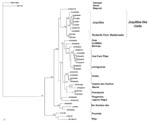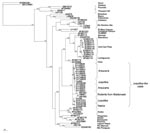Volume 14, Number 9—September 2008
Dispatch
Juquitiba-like Hantavirus from 2 Nonrelated Rodent Species, Uruguay
Abstract
Serologic and genetic analyses indicate that a Juquitiba-like hantavirus circulates in Maldonado, Uruguay. This virus is carried by 2 rodent species, Oligoryzomys nigripes and Oxymycterus nasutus. The same hantavirus in 2 nonrelated species can be explained by a spillover infection or a host-switching event.
Most hantaviruses (family Bunyaviridae) are hosted by 1 or a few closely related rodent species, including rodents of the family Cricetidae, subfamily Sigmodontinae (1). Sigmodontine rodents are highly diverse and comprise ≈84 genera (2); several hantavirus lineages associated with species belonging to 3 of its tribes—Akodontini, Oryzomyini, and Phyllotini—have been characterized (3–5).
In Uruguay, 2 closely related hantaviruses—Lechiguanas and Andes Central Plata—cause hantavirus pulmonary syndrome (HPS). Each of these viruses is carried by the yellow pigmy rice rat (Oligoryzomys flavescens) (6). We report an HPS case in Maldonado, Uruguay, and describe the serologic and genetic analysis carried out on rodents captured at the presumed site of infection.
A case of HPS was diagnosed at the Uruguayan Department of Maldonado in February 2005. The patient worked and lived in a greenhouse near Punta Ballena (34°55′S, 55°3′W).
To determine the source of the patient’s infection, during March 12–15 and December 10–11, 2005, small mammals were trapped near where the patient had lived or worked during the 6 weeks before the onset of symptoms and in nearby habitats. Established biosafety guidelines were followed (7). Each specimen was identified in the field by using external characteristics. Taxonomic identification of seropositive rodents was corroborated by analyzing skull characteristics and by comparing mitochondrial DNA sequences with sequences available in GenBank. Voucher specimens were deposited at the Mammal Collection of the Facultad de Ciencias, Universidad de la República, Montevideo, Uruguay.
In March 2005, during 1,100 trap nights, 133 rodents belonging to the subfamilies Sigmodontinae (family Cricetidae) and Murinae (family Muridae) were collected (trap success rate 12.1%). Nine months later, in December, 45 rodents belonging to the same subfamilies were collected (trap success rate 8.2%) (Table 1). Immunoglobulin G antibodies to Maciel hantavirus were detected by ELISA (6) in 5 rodents (collected in March): 4 long-nosed mice (genus Oxymycterus), 6% seroprevalence, and 1 black-footed pigmy rice rat (Oligoryzomys nigripes), 3.2% seroprevalence. (Maciel antigen for the ELISAs was kindly provided by S. Levis, Instituto Nacional de Enfermedades Virales Humanas, Argentina.) A serum dilution was considered positive if optical density was >0.2 U after adjustment. A serum titer >400 was considered positive. Titration showed that all samples had titers >6,400.
Molecular methods corroborated the field identification of the 1 black-footed pygmy rice rat and assigned the 4 long-nosed mice to 1 of the 2 species of Oxymycterus inhabiting Uruguay: O. nasutus. All 5 specimens (3 male, 2 female) were captured in areas of human disturbance: road borders, shrublands, and artificial pine woods (Acacia spp. or Eucalyptus spp.).
Total RNA was extracted from lung tissue of seropositive rodents and from serum of the HPS patient (6). Nested or seminested reverse transcription–PCRs (RT-PCRs) were performed for partial small (S) and medium (M) segments (8,9). PCR products were sequenced with the same primers used in the RT-PCRs. Viral RNA was detected in 4 of 5 rodents that were seropositive for M or S segments; material was not available for viral RNA testing for 1 O. nasutus mouse. RT-PCR amplification attempts on the patient’s serum failed for both segments.
M segment amplicons (G2 glycoprotein–encoding region) were 735 bp; S segment amplicons were 416 bp. No sequence was obtained from sample PB1011. Similarly, the sequence of the M segment from sample PB981 was not long enough to be included in the phylogenetic analyses. For sequence comparison and phylogenetic analyses, sequences of representative New and Old World hantaviruses were obtained from GenBank. Phylogenetic analyses were conducted by using Bayesian inference and maximum parsimony (Figures 1, 2).
Bayesian analysis based on partial M segment sequences (Figure 1) showed that the sequences retrieved from 1 black-footed pygmy rice rat (PB1033) and 1 long-nosed mouse (PB1002) form a strongly supported clade (posterior probability [PP] 0.97). The Uruguay clade is sister to a clade (PP 1.00) formed by Juquitiba (JUQ) hantaviruses retrieved from black-footed pigmy rice rats (prefix On and AY963900) in Brazil and human HPS case-patients (Hu) in Brazil. We refer to this strongly supported (PP 1.00) clade formed by Brazil and Uruguay sequences as the JUQ-like clade. This clade is sister to Maporal hantavirus. Maximum-parsimony analysis (available from A. Delfraro upon request) also recovers the JUQ-like clade (bootstrap support 100%).
Phylogenetic analysis of S-segment sequences showed a broader taxonomic coverage than that of the M segment (Figure 2). The clade containing the viruses from Uruguay is part of a larger and strongly supported (PP 1.00) clade also formed by JUQ hantaviruses from Argentina (EU373731 from an HPS case-patient; EU373729 from a black-footed pygmy rice rat) and Brazil (Hu256 and Hu063 from HPS case-patients; EF446280 from a black-footed pygmy rice rat), as well as by Araucaria viruses (from HPS case-patients from Brazil) and Itapúa viruses from southern Paraguay, a viral lineage also detected in black-footed pygmy rice rats (DQ345765-66). (Sequences from Brazil JUQ hantaviruses, isolated from O. nigripes and HPS case-patients, were kindly provided by S. Levis, Instituto Nacional de Enfermedades Virales Humanas, Argentina.)
Remarkably, JUQ and Araucaria viruses do not form monophyletic groups. The JUQ-like clade is sister to a clade formed by Hu39694, Ñeembucu, Bermejo, Andes Central Plata, Lechiguanas, and Oran; however, this relationship is weakly supported. Maximum-parsimony analysis (not shown) also recovers a strongly supported JUQ-like clade (bootstrap support 100%).
Sequence comparison for M and S segments showed that hantaviruses that cluster in the JUQ-like clade, including the Uruguay samples, form a homogeneous group that shows a high identity percentage at the nucleotide and amino acid levels. Under the general time reversible + gamma + proportion invariant model, the most similar lineages to the JUQ-like viruses are Hu39694 for the M segment and Oran for the S segment (Table 2).
Genetic and phylogenetic analyses showed that in Maldonado, O. nigripes and O. nasutus carried the same type of hantavirus. Moreover, the viruses from Uruguay form a well-supported clade with JUQ, Araucaria, and Itapúa viruses from HPS case-patients and black-footed pigmy rice rats (O. nigripes) from Argentina, Brazil, and Paraguay. In view of the high sequence similarity and the well-supported phylogenetic relationship, we propose that all of these viruses should be considered as JUQ-like hantaviruses. Additional studies will clarify whether all the viruses in the JUQ-like clade represent 1 viral type.
No Oxymycterus spp. has been previously reported as being a hantavirus reservoir host. Antibodies to hantavirus in Uruguay Oxymycterus spp. may be interpreted as a secondary infection (spillover) (10). Interestingly, in the trapping area, the long-nosed mice are the most abundant rodent species, and the seroprevalence of hantavirus among them (6%) is higher than that previously reported in Uruguay (6). Black-footed pygmy rice rats are the second most abundant rodent captured; however, the seroprevalence of hantavirus among them (3.2%) is lower.
The presence of the same or similar hantavirus in 2 different rodent species may represent an event of host switching (5,11–14). Hantaviruses detected in Maldonado are similar, although not identical, and are carried by 2 distantly related rodent species that belong to different tribes, Akodontini (Oxymycterus) and Oryzomyini (Oligoryzomys). Further investigation of the O. nasutus–derived hantaviruses is needed to elucidate whether long-nosed mice are true reservoirs or only incidental hosts. Clarification may come from complete sequencing of M and S segments, viral isolation attempts, and new capture expeditions to look for more seropositive long-nosed mice in different areas of Uruguay.
Dr Delfraro is an assistant professor in the Virology Section, School of Sciences, Universidad de la República, and a researcher in the Program for the Development of Basic Sciences. Her research interests are rodent-borne and vector-borne viruses.
Acknowledgment
This work was supported by Ministerio de Educación y Cultura, Programa de Desarrollo Tecnológico: PDT 29/148 (Contrato BID 1293/OC-UR), Red Iberoamericana en Virosis Emergentes (RIVE-CYTED), and Conselho Nacional de Desenvolvimento Científico e Tecnológico–Projetos, Supervisão e Planejamento Ltda.
References
- Plyusnin A, Morzunov SP. Virus evolution and genetic diversity of hantaviruses and their rodent hosts. Curr Top Microbiol Immunol. 2001;256:47–75.PubMedGoogle Scholar
- D’Elía G, Pardiñas UFJ. Putting names to the phylogenetic diversity of neotropical sigmodontine rodents: new genera for known species. Mammalia. 2007;71:143–5. DOIGoogle Scholar
- Iversson LB, da Rosa AP, Rosa MD, Lomar AV, Sasaki Mda G, LeDuc JW. Human infection by hantavirus in southern and southeastern Brazil [in Portuguese]. Rev Assoc Med Bras. 1994;40:85–92.PubMedGoogle Scholar
- Levis S, Morzunov SP, Rowe JE, Enria D, Pini N, Calderon G, Genetic diversity and epidemiology of hantaviruses in Argentina. J Infect Dis. 1998;177:529–38.PubMedGoogle Scholar
- Morzunov SP, Rowe JE, Ksiazek TG, Peters CJ, St Jeor SC, Nichol ST. Genetic analysis of the diversity and origin of hantaviruses in Peromyscus leucopus mice in North America. J Virol. 1998;72:57–64.PubMedGoogle Scholar
- Delfraro A, Clara M, Tome L, Achaval F, Levis S, Calderon G, Yellow pigmy rice rat (Oligoryzomys flavescens) and hantavirus pulmonary syndrome in Uruguay. Emerg Infect Dis. 2003;9:846–52.PubMedGoogle Scholar
- Mills J, Childs J, Thomas G, Ksiazek G, Peters CJ. Methods for trapping and sampling small mammals for virologic testing. Atlanta: Centers for Disease Control and Prevention; 1995.
- Raboni SM, Rubio G, De Borba L, Zeferino A, Skraba I, Goldenberg S, Clinical survey of hantavirus in southern Brazil and the development of specific molecular diagnosis tools. Am J Trop Med Hyg. 2005;72:800–4.PubMedGoogle Scholar
- Suzuki A, Bisordi I, Levis S, Garcia J, Pereira LE, Souza RP, Identifying rodent hantavirus reservoirs, Brazil. Emerg Infect Dis. 2004;10:2127–34.PubMedGoogle Scholar
- Levis S, Garcia J, Pini N, Calderon G, Ramirez J, Bravo D, Hantavirus pulmonary syndrome in northwestern Argentina: circulation of Laguna Negra virus associated with Calomys callosus. Am J Trop Med Hyg. 2004;71:658–63.PubMedGoogle Scholar
- Monroe MC, Morzunov SP, Johnson AM, Bowen MD, Artsob H, Yates T, Genetic diversity and distribution of Peromyscus-borne hantaviruses in North America. Emerg Infect Dis. 1999;5:75–86.PubMedGoogle Scholar
- Nemirov K, Henttonen H, Vaheri A, Plyusnin A. Phylogenetic evidence for host switching in the evolution of hantaviruses carried by Apodemus mice. Virus Res. 2002;90:207–15. DOIPubMedGoogle Scholar
- Sanchez AJ, Abbott KD, Nichol ST. Genetic identification and characterization of limestone canyon virus, a unique Peromyscus-borne hantavirus. Virology. 2001;286:345–53. DOIPubMedGoogle Scholar
- Vapalahti O, Lundkvist A, Fedorov V, Conroy CJ, Hirvonen S, Plyusnina A, Isolation and characterization of a hantavirus from Lemmus sibiricus: evidence for host switch during hantavirus evolution. J Virol. 1999;73:5586–92.PubMedGoogle Scholar
Figures
Tables
Cite This ArticleTable of Contents – Volume 14, Number 9—September 2008
| EID Search Options |
|---|
|
|
|
|
|
|


Please use the form below to submit correspondence to the authors or contact them at the following address:
Juan R. Arbiza Rodonz, Facultad de Ciencias, Sección Virología, Iguá 4225, Montevideo 11400, Uruguay;
Top